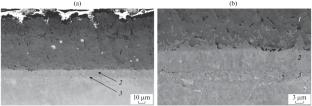Analytical Determination of the Effective Thermal Conductivity of Heterophase Surface Layers, Coatings, and Thin Films in Heavy-Loaded Tribosystems
Abstract—
The aim of the study was to create a technique for calculating the thermal conductivity of a thin surface layer or coating, which differs significantly from the base metal in structure, phase composition, and thermal properties. The technique is based on the experimental measurement of the contact potential difference (CPD) at the layer/coating–substrate interface, followed by the calculation of the electron work function and the energy of the Fermi level. Distinctive features of the developed methodological apparatus are the characteristics of the microstructure, phase composition, and porosity of the layer/coating, which are taken into account in the calculation model and significantly affect the final result of determining the effective thermal conductivity. The calculation and experimental approbation of the idea was implemented in the process of studying the blades of an experimental gas turbine locomotive engine with a heterophase thermal barrier coating of the Nb–Ti–Al system. The material of the blades is Inconel 713LC cast chromium–nickel superalloy. Coatings with a thickness of about 80 µm were deposited using the vacuum ion-plasma technology. During the development of the methodology for calculating the thermal conductivity, the experimental data of the CPD were obtained by instrumental measurements according to a specially developed laboratory procedure. Data on the morphology of the structure of coatings, their phase composition, and porosity were studied by traditional metal-physical methods and integrated into the calculation part of the technique. The results of model calculations of the thermal conductivity of both the base metal of the substrate (turbine blades) Inconel 713LC and the Nb–Ti–Al thermal barrier coating showed a high agreement with experimental and reference data. The technology has a high potential for application in heavily loaded friction units in various areas of the national economy, such as helicopter construction, aircraft construction, aerospace, railway transport, shipbuilding, and defense.


 求助内容:
求助内容: 应助结果提醒方式:
应助结果提醒方式:


